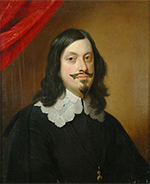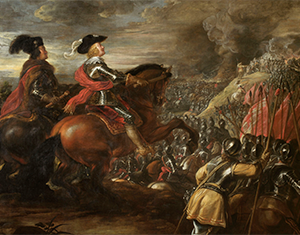Ferdinand III: King of Germany, Holy Roman Emperor
Ferdinand III was King of Germany and Holy Roman Emperor for a time in the 17th Century. He was notably emperor when the Thirty Years War ended. He was born in Graz, in Styria, on July 13, 1608. His father was the eventual Holy Roman Emperor Ferdinand II, and his mother was Maria Anna of Bavaria. The boy grew up in Carinthia and trained with Jesuits. He made it a point, at some point during his life, to learn the languages spoken by all of his subjects: Czech, French, German, Hungarian, Italian, and Spanish. He also was fluent in Latin. 
Ferdinand the elder had lost his two eldest sons, Karl in 1603 and Johann Karl in 1619. The father very much had succession on his mind when he named his son Ferdinand Archduke of Austria in 1621, when the boy was just 13. Other thrones followed, with the still-teenaged Ferdinand taking the Hungarian crown in 1625 and then the Bohemian crown two years later. Running the imperial war effort during this time was the veteran Albrecht von Wallenstein of Bohemia, who had great success in the early days but had to give way when Sweden entered the war. Wallenstein found himself relieved from his command and then reinstated. All the while, young Ferdinand was campaigning to run the army. Wallenstein's downfall came in 1634, when Ferdinand II himself ordered the commander done away with on charges of Father completed the succession handover to son in 1636, when German electors named Ferdinand the younger as King of the Romans. A year later, when Ferdinand II died, the transition to his son was orderly. The younger Ferdinand married three times. The first was to Maria Anna of Spain in 1631. They had six children together: Ferdinand (1633), Maria Anna called "Mariana" (1634), Philip August (1637), Maximilian Thomas (1638), Leopold (1640), and Maria (1646). Empress Maria Anna died in 1646. Two years later, Ferdinand married again, to Maria Leopoldine of Austria; they had a son, Karl Josef, born in 1649. The empress died that same year, and Ferdinand married again two years later, to Eleonora Gonzaga; they had four children, two of whom lived into adulthood: Eleonora Maria (1653) and Ferdinand Josef (1657). When Ferdinand III took the imperial throne, the empire was in the middle of a continentwide conflict, the Thirty Years War. Ferdinand II had in 1635 secured (with his son's invaluable assistance) the Peace of Prague, which brought a modicum of nonconflict. The entry of France into the war tipped the balance against imperial forces, and the conflict once again engulfed German states. As the war dragged on, Ferdinand III granted the rulers of the various German states the ability to prosecute their own foreign policy. This change produced a short-term gain, as more of those states carried on in the imperial vein; however, this development eventually led to a decrease in central imperial authority. The 1648 Peace of Westphalia ended the war for all but France and Spain, both of which carried on their war. Ferdinand was not happy with the terms of the Peace but at that point had little power to object successfully. He sent an army into Italy in 1656, to help Spain against France. Operating on several fronts, Ferdinand had also secured an agreement with Poland to counteract the growing influence of Sweden's Carl Gustav. Through these years, the devastated German states and other elements of the once dominant Holy Roman Empire struggled to rebuild. As the Protestant Reformation gave way to the Catholic Counter Reformation, Ferdinand remained steadfast that Catholicism ruled in Austria and Bohemia; at the same time, he presided over the ascendancy of Protestantism in the German states. In the midst of all of this, Ferdinand died, on April 2, 1657. His oldest surviving son (his first son, Ferdinand, having died in 1654) succeeded him as Leopold I. |
|
Social Studies for Kids
copyright 2002–2025
David White



 corruption. The younger Ferdinand then assumed command of the army. He won a handful of victories, including the decisive 1634 Battle of Nördlingen.
corruption. The younger Ferdinand then assumed command of the army. He won a handful of victories, including the decisive 1634 Battle of Nördlingen.
